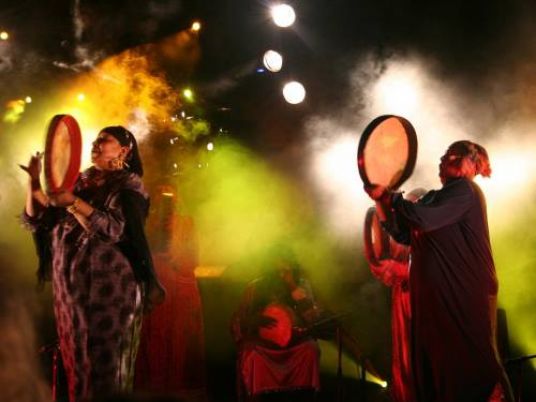A description of Zar ceremonies and the psychological, physical, social, economic, and aesthetic aspects of the Zar ritual.
Source: extracts from Adel Elelimi’s study published in Zar and the Theatre of Rituals.
Types of Zar
1-The Saidi (Upper Egyptian)
This Zar ritual starts with the woman for whom the Zar is held. It is limited to women only performers and guests. The arousa (the bride/doll) – dresses in white and is led by a zaffa (march) around the korsy (chair – actually a rectangular table bearing food for the assiad – higher jinn). Then verses from the Quran are recited, and incense is burned (the Quran forms the background of the Zar ritual since jinn are extensively mentioned in the Quran) and the Zar performers chant three dor (songs): one for the arousa, one for the assiad, and the third for the guests. Then follows a bird scene where the arousa sits on the floor and the kodia (Zar leader) holds a pigeon, puts it on her shoulders and then on her head. The arousa dances to the rhythm and subsequently the bird is slaughtered as commanded by the assiad.
2- The Sudanese
This Zar is performed by men and women. The main musical instrument is the tanboura, an ancient African musical instrument. The ritual is similar to the Sayedi Zar, but the arousa dresses in a light blue color and the zaffa is preceded by two black men wearing belts made of sheep claws, followed by three women and a man dressed in feathers and necklaces, with metal ornaments around his limbs. The arousa follows them carrying a doff (a kind of drum) and holding part of the tanboura on her shoulder. Following that, the ritual resembles the Saidi Zar
3- Abul Gheit
This is only performed by men. It starts with the zaffa, whereby the arousa walks in and is followed by some of the Zar members, preceded by one of the tanoura dancers (popular in folk culture with the dancer spinning very rapidly in a big skirt-like cloth) holding a tara, (a larger sized metal music ornament usually held in the hands of belly dancers – similar to the Spanish castanet). The rest of the performers use whistles and are dressed in white, with green tarboush and long, loose hair. They are known to chant songs about the love of Prophet Mohammed and in remembrance of the awliaa (the blessed ones). The ritual then follows the same pattern as the Saidi and the Sudanese rituals
Zar functions:
Psychological
It is more of a group therapy for people undergoing suffering; no one is made to feel shame as the Zar is a psychological outlet for anything disturbing, such as not being married, or not being able to bear children. A person may take refuge in Zar.
Physiological
The rhythmical movement along with the Zar beats and the burning of incense, and the whole atmosphere in general, enable those taking part in the ritual to reach a state of trance or shock that leads them to collapse completely and then regain their conscience and hence their vitality.
Social
Many women belonging to the lower classes live under a lot of pressure due to their social obligations, from running households, to answering to their husband’s demands. Hence the Zar forms a social outlet whereby women change their routine, socialize with other women and exchange experiences. There are also sea and mountain Zars, conceived as outings and one day events.
Economic
Zar provides an income for those who perform, through the noout donations made by all those who attend.
Beauty
From the point of view of its participants, the Zar ritual offers freedom which they lack in their daily life, with all of its constraints. and enjoy the beauty of life.
.

